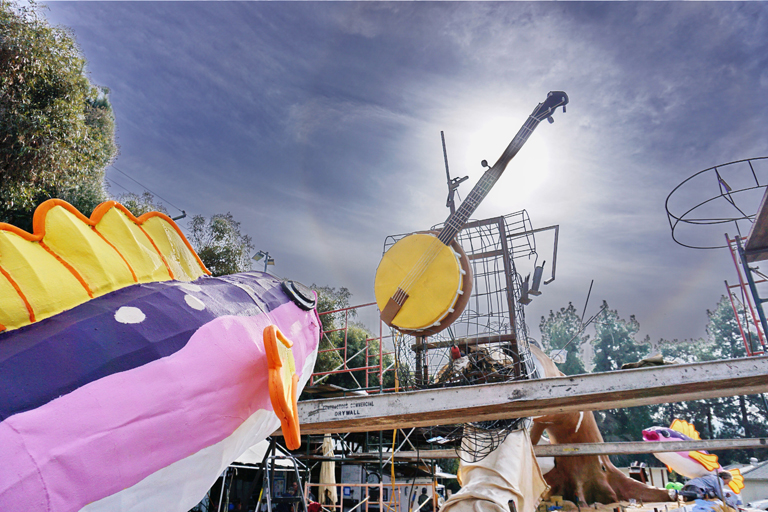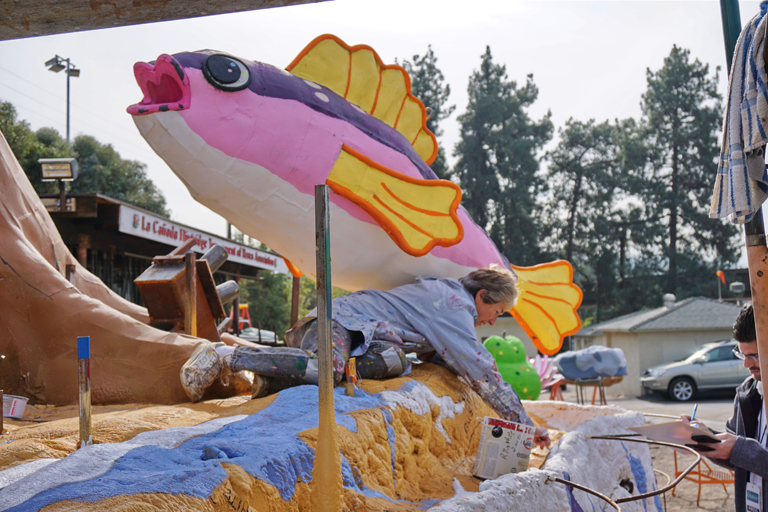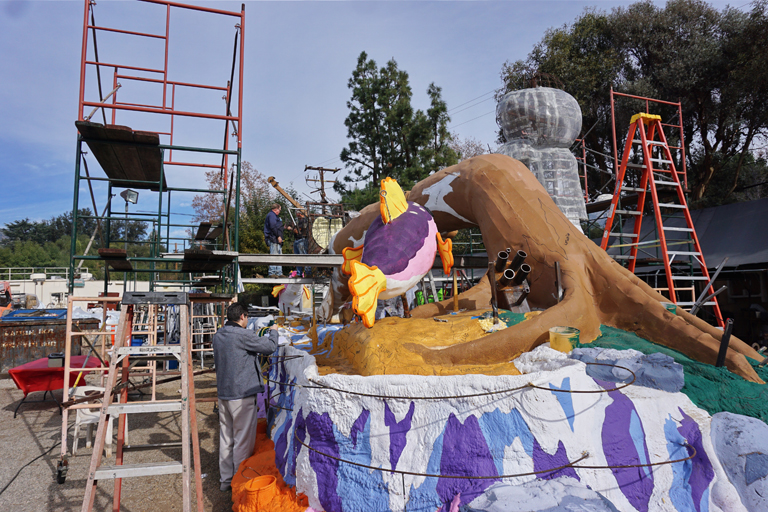
A banjo is situated on the City of La Cañada’s entry in the 2019 Rose Parade. The instrument is just one component of the float that showcases a concert that includes frogs in a band playing bass, harmonica and banjo.
Local organizations prepare their interpretations of parade theme “The Melody of Life.”
By Mary O’KEEFE and Charly SHELTON
Those watching the Rose Parade, either in person or remotely, see it as a celebration of communities across the country, and the world, coming together to ring in the New Year. But it takes a lot of work from thousands of volunteers to make it look so easy.
One of the most visual aspects, of course, is the floats. These are created by companies, organizations and cities including the La Cañada Flintridge Tournament of Roses Assn. and the American Armenian Rose Float Assn.
LCFTRA entered its first float in the Rose Parade in 1979 with Horse Play; the theme that year was the Wonderful World of Sports. Over the years, the Association has gathered volunteers to help in every aspect of float building. For most in the area, a sure sign the New Year is approaching is when the city’s float can be seen under the Foothill (210) Freeway bridge at the corner of Hampton Road and Foothill Boulevard as it is worked on by hundreds of volunteers with thousands of buckets of flowers.
Chuck Terhune has been with the LCFTRA for many years. He is a past president and presently serves as the vice president of float development. This year the Rose Parade theme is “The Melody of Life” and the LCFTRA float is titled “Tree-Frog Night.”
“It is about the power of music,” Terhune said. “The theme ‘Melody of Life’ has a huge range of interpretation but it is about how music can affect you.”
He added how songs can inspire memories, from children to adults. The Association’s float has a Louisiana bayou feel.
“[Our float] is about three Cajun frogs in the Bayou who are having a concert for the critters,” Terhune said.
The concert includes the frogs in a band playing bass, harmonica and banjo. The music parade watchers will hear as the float rolls down Colorado Boulevard will be a variety of songs recorded by professional musicians who are volunteers for the float. Terhune didn’t have the exact count of how many flowers will be adhered but estimates anywhere from 10,000 to 15,000 roses.
“This year we will have iris [flowers] because we have water [featured] on the float,” he added. “We will have a lot of blue statice flowers.”
Those blue flowers will help highlight the waterfall design on the float. All the frogs are done in green “Kermit” flowers, which are actually a green button pom flower. The design also includes several lily pads so there will be a lot of lilies. There are also some dancing fish.
“It is going to be a fun float,” Terhune said.
For its Rose Parade entry, the American Armenian Rose Float Assn. reached back into history for its theme “Chanting Stones: Karahunj.”
The design was inspired by the stones of Karahunj, a monument that is often referred to as the Armenian Stonehenge. Karahunj is a prehistoric formation of megaliths set in Armenia’s Syunik Province. Karuhunj means speaking or chanting stones. This design was conceived by AARFA board member Johnny Kanounji.
“At night when the wind blows through the stones it sounds [like] the stones are chanting,” said Arthur Kokozian, the fundraising/corporate sponsor committee director of the AARFA.
The AARFA is not tied to any other Armenian organization or church. It hopes this first float entry will be the foundation of a legacy that will share with the world the rich Armenian culture. Armenia has a recorded history of about 3500 years dating back to 1200 BCE.
Kokozian said Armenians have a long history of contributions to the world and can reach into their past as well as look at the present to meet any theme the Tournament of Roses may have.
Along with the foundation of the chanting stones, the float celebrates the Melody of Life theme in several ways including a duo of dancers performing an Armenian folk dance called yarkhushta. The dance is performed by pairs of men facing each other.
“The key element of the dance is a forward movement when participants rapidly approach one another and vigorously clap onto the palms of hands of dancers in the opposite row,” according to AARFA. “The tune of the dance is played intentionally very loudly by two zurna hornpipes and one or more double-headed bass drums, each struck with a mallet and a stick from opposite sides of the drum’s cylinder.”
Music will also be performed by a musician playing the dudik, an instrument made of apricot wood. The float will also be adorned with apricot trees, indigenous to Armenia.
The two floats will be among 40 that make their way along Colorado Boulevard. There will also be marching bands, civic organizations and equestrian units that will join the Rose Court and Grand Marshal Chaka Khan for the 130th Rose Parade that begins at 8 a.m. on Jan. 1, 2019.


